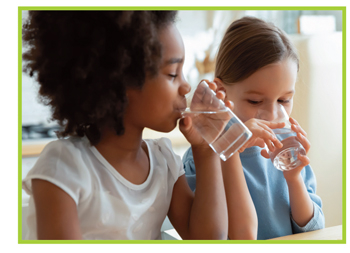
AVAILABLE FOR DOWNLOAD AS PDF
- 2024 Annual Water Quality Report
- Informe anual de calidad del agua 2024
- 2024 Taunang Ulat sa Kalidad ng Tubig
- 2024 年度水质报告
TO REQUEST A PRINTED COPY
Please submit a request through the Contact Us page or call 650-589-1435.
IMPORTANT CHLORAMINE NOTICE: The District gets its water from the San Francisco Water Department (SFPUC). The SFPUC uses chloramine (a mixture of chlorine and ammonia) to disinfect the water. Chloraminated water is safe for people and animals; however, precautions must be taken to remove or neutralize chloramine during kidney dialysis process, in the preparation of water for fish tanks and ponds, and for businesses requiring highly processed water. Please ask District personnel for additional information.

The Westborough Water District provides its customers with high quality drinking water that is safe to drink and meets standards set by the California Department of Health Services and the United States Environmental Protection Agency.
The Westborough Water District receives 100 percent of its water from the San Francisco Water Department. The water comes from Hetch Hetchy in Yosemite National Park and local reservoirs.
The California Department of Health Services and the United States Environmental Protection Agency set standards for drinking water quality.
The District collects samples throughout the system weekly to be analyzed for coliform bacteria, chlorine residual, pH, and turbidity. Every three months the District collect samples to monitor for trihalomethanes, or THMs, compounds formed when the chlorine used for disinfection reacts with naturally occurring organic compounds found in water. Water quality is monitored daily at the Harry Tracy treatment plant by the San Francisco Water Department.
Water Quality Reports
- 2023 Annual Water Quality Report (PDF)
- Informe anual de calidad del agua 2023
- 2023 Taunang Ulat sa Kalidad ng Tubig (PDF)
- 2023 年度水质报告 (PDF)
- 2022 Annual Water Quality Report (PDF)
- Informe anual de calidad del agua 2022 (PDF)
- 2021 Annual Water Quality Report (PDF)
- 2020 Annual Water Quality Report (PDF)
- 2019 Annual Water Quality Report (PDF)
- 2018 Annual Water Quality Report (PDF)
- 2017 Annual Water Quality Report (PDF)
- Fluoride Information (PDF)
- Chloramine Information (PDF)
- Per- and Polyfluoroalkyl Substances (PFAS) Information (PDF)
Our Drinking Water Sources and Treatment
The San Francisco Public Utilities Commission provides 2.7 million customers in cities and towns across the region through its San Francisco Regional Water System (SFRWS) with water so high quality that it meets all federal and state standards. They are committed to providing high-quality drinking water for all its customers.

The Westborough Water District purchases 100% of its water from the San Francisco Public Utility Commission (SFPUC). Our drinking water supply consists of surface water and groundwater that are well protected and carefully managed. The surface water is stored in reservoirs in the Sierra Nevada, Alameda County, and San Mateo County, and the groundwater is kept in a deep aquifer in the northern part of San Mateo County. Maintaining this variety of sources is an important component of the near- and long-term water supply management strategy of the San Francisco Public Utilities Commission (SFPUC). A diverse mix of sources protects us from potential disruptions due to emergencies or natural disasters, provides resiliency during periods of drought, and helps us ensure a long-term, sustainable water supply as we address issues such as climate uncertainty, regulatory changes, and population growth.
To meet drinking water standards for human consumption, all surface water the SFPUC supplies must undergo proper treatment. Water from Hetch Hetchy Reservoir is exempt from state and federal filtration requirements due to its exceptional quality. It undergoes disinfection using ultraviolet light and chlorine, pH adjustment for optimum corrosion control, fluoridation for dental health protection, and chloramination for maintaining disinfectant residual and minimizing the formation of regulated disinfection byproducts. Water from local Bay Area reservoirs in Alameda County and upcountry non-Hetch Hetchy sources are delivered to the Sunol Valley Water Treatment Plant. Water from reservoirs in San Mateo County is delivered to the Harry Tracy Water Treatment Plant. Water treatment at these plants consists of filtration, disinfection, fluoridation, taste and odor removal, and optimum corrosion control. In 2024, neither upcountry non-Hetch Hetchy sources of water nor groundwater was used.
Water Quality
We regularly collect and test water samples from reservoirs and designated sampling locations throughout the systems to ensure that the water delivered to you meets all federal and state drinking water standards. In 2024, the SFRWS conducted more than 45,650 drinking water tests of samples from source and transmission system locations. This is in addition to the extensive treatment process control monitoring performed by our certified operators and online instruments.
As water travels over the surface of the land or through the ground it dissolves naturally occurring minerals and, in some cases, radioactive material, and can pick up substances resulting from the presence of animals or human activity. Collectively these are called contaminants. Therefore, drinking water, including bottled water, may reasonably be expected to contain at least small amounts of some contaminants. The presence of contaminants does not necessarily indicate that water poses a health risk. To ensure that tap water is safe to drink, the United States Environmental Protection Agency (USEPA) and the State Water Resources Control Board (SWRCB) prescribe regulations that limit the amount of certain contaminants in water provided by public water systems. The United States Food and Drug Administration regulations and California law also establish limits for contaminants in bottled water that provide the same protection for public health.
 Protection of Watersheds
Protection of Watersheds
The SFRWS conducts watershed sanitary surveys for the Hetch Hetchy source annually and for non-Hetch Hetchy surface water sources every five years. The latest sanitary surveys for the non-Hetch Hetchy watersheds were completed in 2021 for the period of 2016-2020. These surveys document the SFPUC’s stringent watershed protection activities that are implemented with support from partner agencies including the National Park Service and the United States Forest Service.
These surveys not only evaluate the sanitary conditions and water quality of the watersheds but also describe the results of watershed management activities conducted in the preceding years. Wildfire, wildlife, livestock, and human activities continue to be the potential contamination sources. You may contact the San Francisco District Office of the SWRCB Division of Drinking Water at 510-620-3474 for more information.
 Special Health Needs
Special Health Needs
Some people may be more vulnerable to contaminants in drinking water than the general population. Immunocompromised persons, such as those with cancer undergoing chemotherapy, persons who have undergone organ transplants, people with Human Immunodeficiency Virus/Acquired Immunodeficiency Syndrome or other immune system disorders, some elderly, and infants can be particularly at risk from infections. These people should seek advice about drinking water from their healthcare providers.
Cryptosporidium is a parasitic microbe found in surface water. We regularly test for this waterborne pathogen and found it at very low levels in source water and treated water in 2024. However, current test methods approved by the United States Environmental Protection Agency (USEPA) do not distinguish between dead organisms and those capable of causing disease. Ingestion of Cryptosporidium may cause cryptosporidiosis with symptoms of nausea, abdominal cramps, diarrhea, and associated headaches. Cryptosporidium must be ingested to cause disease, and it may be spread through means other than drinking water.
Guidelines on appropriate means to lessen the risk of infection by Cryptosporidium and other microbial contaminants are available from the USEPA’s Safe Drinking Water Hotline at 800-426-4791 or at www.epa.gov/safewater
No Poly-fluoroalkyl Substances (PFAS) Detected
You may have heard about PFAS. These are man-made chemicals that have been used in industry and consumer products worldwide since the 1940s. We did not detect PFAS in our water. To learn more, visit waterboards.ca.gov/pfas
Unregulated Contaminant Monitoring Rule
Fluoridation
We add fluoride to our water. California law mandates fluoridation. It is proven safe. It is also effective at preventing and controlling tooth decay. Our fluoride levels match the state’s optimal level. To learn more, CLICK HERE or go to the CDC website cdc.gov/fluoridation
Drinking Water and Lead
Exposure to lead, if present, can cause serious health effects in people of all ages, especially for pregnant women and young children. Infants and children who drink water containing lead could have decreases in intelligent quotient and attention span as well as increases in learning and behavior problems. The children of women who are exposed to lead before or during pregnancy can have an increased risk of these adverse health effects. Adults can have increased risks of heart disease, high blood pressure, kidney, or nervous system problems.
Lead in drinking water is primarily from materials and components associated with service lines and home plumbing. We are responsible for providing high-quality drinking water and removing lead pipes, but we cannot control the variety of materials used in plumbing components in your home. Because lead levels may vary over time, lead exposure is possible even when your tap sample results do not detect lead at one point in time. You share the responsibility for protecting yourself and your family from the lead in your home plumbing by taking one or more of the following actions:
- Identify and remove lead materials within your home plumbing.
- If you use a water filter, make sure it’s certified for lead to National Sanitation Foundation (NSF)/ANSI standards. Make sure to replace and maintain the filter according to the manufacturer’s instructions.
- Use only cold water for drinking, cooking, and making baby formula (Do not boil your water to remove lead. Boiling water will not remove lead).
- Flush your pipes for several minutes before using your water for drinking, cooking, and preparing baby formula (this can be done by running your tap, taking a shower, doing laundry or a load of dishes, or reusing for watering plants).
- Flush for a longer period if you have pipes made of lead or galvanized material. Visit sfpuc.gov/lead to see an instructional video if you would like to test your pipes.
If you are concerned about lead in your water, you can have your water tested. Information about lead in drinking water, testing methods, and steps you can take to minimize exposure is available at www.epa.gov/safewater/lead.
Lead Service Line Inventory & Replacement
As previously reported, we completed an inventory of lead user service lines (LUSL) in our system and there are no known pipelines and connectors between water mains and meters made of lead. Our policy is to remove and replace any LUSL promptly if it is discovered during pipeline repair and/or maintenance.
In 2024, the Westborough Water District conducted an Initial Lead Service Line Inventory (LSLI) and there were no water system owned or customer owned lead service lines.
Lead and Copper Tap Sampling Results
Boron Detection Above Notification Level in Source Water
Urban Water Management Report
In compliance with the Urban Water Management Planning Act, the Westborough Water District (WWD.) has prepared its sixth updated Urban Water Management Plan (UWMP) under the terms of AB797 (1983) and subsequent amending legislation.
On June 10, 2021, this plan was presented at a Public Hearing and approved by the WWD Board of Directors. It supersedes the existing plan prepared in 2015, and will be used by the District staff to guide the District's water conservation efforts through the year 2025.
Click here for 2020 Urban Water Management Report (UWMP) (PDF)
Click here for 2015 Urban Water Management Report (UWMP) (PDF)

 Protection of Watersheds
Protection of Watersheds Special Health Needs
Special Health Needs